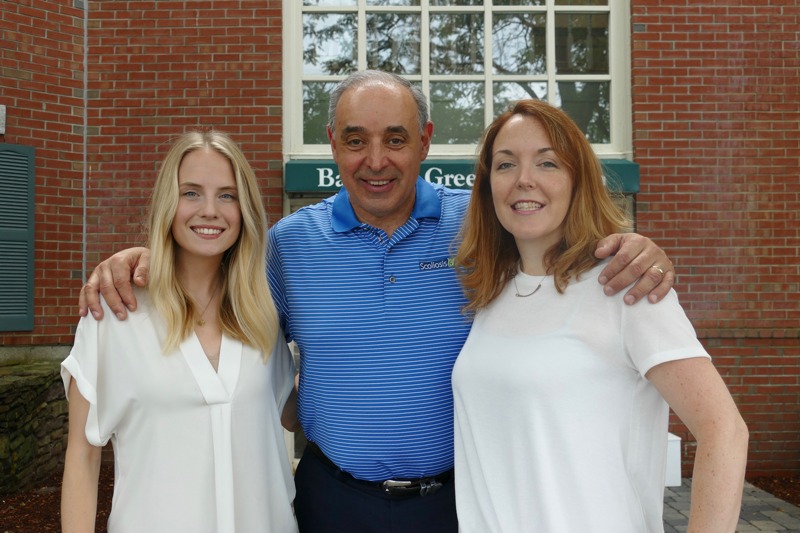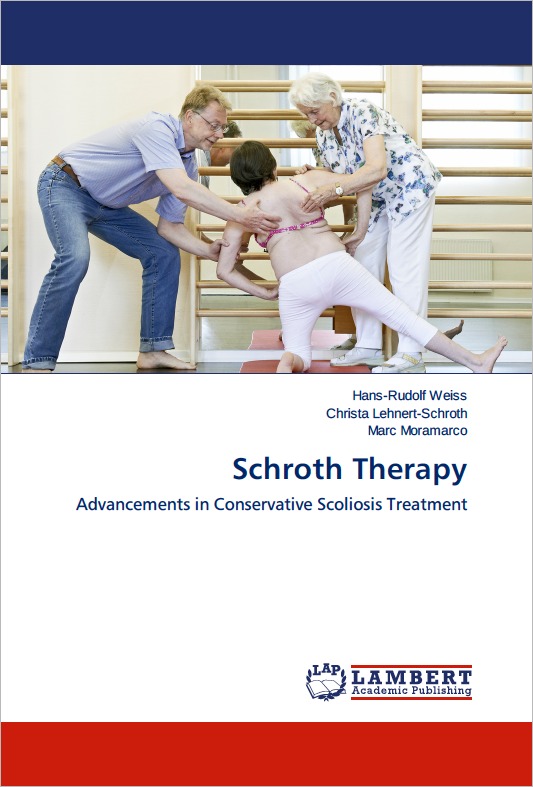What is Schroth Best Practice? Simply put, Schroth Best Practice is the Schroth method improved! It is an evidence-based, effective treatment option for juveniles, adolescents and adults with scoliosis and/or kyphosis of all ages and Cobb angles (mild, moderate, or severe).
Since the creation of the Schroth Method nearly 100 years ago, life has changed. Patients are busy. Kids and their parents are busy. People want and need the least complicated, most efficient path possible–with the best results!
This inspired Dr. Hans-Rudolf Weiss (3rd generation Schroth family) to simplify, update and improve certain aspects of the original Katharina Schroth program. To differentiate the two, he refers to this new evolution of the method as Schroth Best Practice.

What’s the Difference Between Schroth Best Practice and the Schroth Method?
While the concepts are the same, the Schroth Best Practice program is designed to be simpler, yet comprehensive, so that patients are able to practice their curve-pattern specific scoliosis exercises throughout the day. The most effective Schroth method exercises have been maintained in the Best Practice program, while certain others are typically no longer used. One reason for the change is that when originally created, the Schroth Method catered to patients with very severe curves, often greater than 80°. Patients with this type of severe scoliosis did many supine (lying on back) and prone (lying on stomach) floor exercises to reduce the effect of gravity on the spine.
Luckily, over the years, improved scoliosis awareness has led to earlier detection and treatment. The Schroth Best Practice program has eliminated the majority of supine and prone exercises (except in the case of very severe curves) and instead incorporates upright ‘Power Schroth’ exercises, which are more effective at engaging the spinal musculature.
Other amendments include exercises to address the sagittal plane (physiologic), maneuvers to increase flexibility and strength (mobilizations), streamlined 3D Schroth breathing exercises (3D Made Easy) and postural re-education (ADL training) – a powerful tool for curves small or large. The Schroth Best Practice program also emphasizes less reliance on props, making exercise set-up less cumbersome (i.e. more user-friendly). All the above-mentioned changes now allow treatment to be delivered on an outpatient basis of shorter duration than in years past. This new Schroth-based protocol is simpler, more user-friendly, and equally, if not more, effective (1).
Dr. Marc Moramarco, founder of Scoliosis 3DC®, has been trained in both schools and finds that the Best Practice program is the better choice for the majority of his patients.
“Schroth Best Practice updates are simpler for the patient to put into practice immediately. I will instruct a patient, send them to lunch, and they can sit and eat in their newly modified posture in a way that works to counteract progression. It’s a huge win for the patient!”
– Dr. Marc Moramarco
Schroth has documented results including improved Cobb angle measurements (2-4), improved posture (4, 5), a reduction or elimination of pain (6), improved vital capacity and chest expansion (7-8), and improved self-concept (9). The effectiveness of the Schroth Best Practice model has been documented internationally (8, 10-14).
The Scoliosis 3DC® Program
At Scoliosis 3DC®, we offer an evidence-based program focused on educating, enabling and empowering patients to take an active role in managing their scoliosis. Our program is modeled after the German model of immersion training, which has been used successfully for decades. Schroth breathing is a nuanced technique and we find it is best taught in multi-hour sessions as originally intended (not one hour here and there). Immersion training is more efficient as patients benefit from experiential learning, leading to less confusion later on as the longer sessions allow plenty of time for learning, questions, and repetition. Patients are also able to gain the tools they need right away instead of going through long-extended instructional time frames, which is important because scoliosis doesn’t wait!
The Scoliosis 3DC® program incorporates load-altering protocols, which allow patients to effect postural control via self-correction (15) during various activities of daily living (ADLs). This enables patients to more easily internalize their newly formed posture and process it as a motor engram (think recoding the brain through repetition). The purpose of self-correction is so the new postures become second nature. This helps to avoid scoliosis progression by not feeding into the curvature during everyday actions. An important component of self-correction used in many of our exercise protocols is the side-shift technique (a lateral trunk shift to the concavity of the curve), which has been shown to be effective in treating scoliosis (16).

Core Components of the S3DC Program
- Customized Treatment – All patients seen in our office are given personalized 1-on-1 attention during their appointments. Each program begins with an examination, during which Dr. Moramarco provides a treatment plan. While every case is different, patients will typically complete a 12-hour program (mild curves, kyphosis, post-surgical, juveniles) or a 17-hour program (moderate-severe curves).
- Patient Education – Extensive education about scoliosis and your/your child’s unique curve pattern (in all 3 planes).
- ADL Training (Activities of Daily Living) – Learn which postures are favorable or unfavorable and why (17) so you can avoid feeding into curve progression when sitting, standing, walking, lying down, carrying objects, and doing regular activities. (These actions add up when repeated many times throughout your lifetime!)
- Physiologic Exercises – Exercises exclusive to Schroth Best Practice® which help mobilize and correct postural imbalances in the sagittal plane and are validated by recent research (18, 19).
- Mobilizations – Simple active, passive, and active-assistive maneuvers used to increase spinal flexibility and range of motion.
- 3D Made Easy – A combination of ADLs and rotational breathing to create a streamlined Schroth exercise that is simple, powerful, and can be done anywhere. 3D Made Easy exercises are exclusive to Schroth Best Practice® and allow patients to practice throughout the day and increase compliance.
- Schroth Exercises – Rotational breathing exercises designed to engage core muscles and lengthen and strengthen in a corrected position.
- Personalized Exercise Binder and Video – Once you complete the program, we provide a binder with written instructions for all of your exercises, checklists to help keep you on track, and a video recording of your program for you to reference whenever needed.
- Schroth Compatible Bracing – If bracing applies to your case, measurement and fitting can be scheduled alongside an intensive Schroth program. The Chêneau-Gensingen brace, a Schroth compatible scoliosis brace, is available at our office. We also offer the Kyphologic brace for patients with thoracic kyphosis, and the Physiologic brace for adults with thoracolumbar/lumbar kyphosis.

When it comes to choosing the right Schroth method program, personal commitment and experience matter. Our team is dedicated to helping you along your scoliosis journey. Click here to learn more about Dr. Moramarco’s expertise with the Schroth method and Schroth Best Practice.
Schroth Therapy Book
 “Schroth Therapy: Advancements in Conservative Scoliosis Treatment” is the newest Schroth Method book for nonsurgical scoliosis management using Schroth Best Practice techniques. Dr. Marc Moramarco of Scoliosis 3DC® collaborated with 2nd and 3rd generation Schroth family members, the late Christa Lehnert-Schroth, PT and Dr. Hans-Rudolf Weiss, to author this book – available on Amazon.
“Schroth Therapy: Advancements in Conservative Scoliosis Treatment” is the newest Schroth Method book for nonsurgical scoliosis management using Schroth Best Practice techniques. Dr. Marc Moramarco of Scoliosis 3DC® collaborated with 2nd and 3rd generation Schroth family members, the late Christa Lehnert-Schroth, PT and Dr. Hans-Rudolf Weiss, to author this book – available on Amazon.
Please note: this book was not intended to be a self-teaching guide but an introduction to Schroth principles. There is a chapter on technique; however, we recommend all patients undertake Schroth exercises only after individualized instruction by a Schroth Best Practice® certified practitioner. Clinicians require special training to be certified in Schroth Best Practice® (SBP). In the U.S., Dr. Moramarco is the Schroth Best Practice Advanced Instructor who coordinates courses and leads trainings for practitioners seeking SBP certification.
References
1) Weiss HR, Seibel S. Scoliosis short-term rehabilitation (SSTR) —a pilot investigation. The Internet Journal of Rehabilitation 2010;1.
2) Fusco C, Zaina F, Atanasio S, Romano M, Negrini A, Negrini S: Physical exercises in the treatment of adolescent idiopathic scoliosis: an updated systematic review. Physiother Theory Pract. 2011;27(1):80-114.
3) Weiss HR, Weiss G, Petermann F. Incidence of curvature progression in idiopathic scoliosis patients treated with scoliosis inpatient rehabilitation (SIR): an age- and sex-matched controlled study. Pediatr Rehabil. 2003;6(1):23–30.
4) Otman S, Kose N, Yakut Y: The efficacy of Schroth s 3-dimensional exercise therapy in the treatment of adolescent idiopathic scoliosis in Turkey. Saudi Medical Journal 2005; 26: 1429–1435.
5) Lehnert-Schroth Christa: Three-dimensional treatment for scoliosis. A physiotherapeutic method to improve deformities of the spine. Palo Alto, CA, 2007; The Martindale Press.
6) Weiss HR. Scoliosis-related pain in adults – treatment influences. Eur J Phys Rehabil Med. 1993;3:91–94.
7) Weiss HR. The effect of an exercise program on VC and rib mobility in patients with IS. Spine. 1991;16:88–93.
8) Moramarco M., Fadzan M., Moramarco K., Heller A., Righter S. The Influence of Short-Term Scoliosis-Specific Exercise Rehabilitation on Pulmonary Function in Patients with AIS. Curr. Pediatr. Rev. 2016;12(1):17–23.
9) Weiss HR, Cherdron J. Effects of Schroth’s rehabilitation program on the self concept of scoliosis patients. Rehabilitation. 1994;33(1):31-34.
10) Weiss HR, Klein R. Improving excellence in scoliosis rehabilitation: a controlled study of matched pairs. Pediatr Rehabil. 2006;9(3):190–200.
11) Borysov M, Borysov A. Scoliosis short-term rehabilitation (SSTR) according to ‘Best Practice’ standards – are the results repeatable? Scoliosis. 2012;7:1.
12) Pugacheva, N. Corrective exercises in multimodality therapy of idiopathic scoliosis in children – analysis of six weeks efficiency – pilot study. Stud Health Technol Inform. 2012; 176:365-371.
13) Lee SG. Improvement of curvature and deformity in a sample of patients with Idiopathic Scoliosis with specific exercises. OA Musculoskeletal Medicine. 2014; Mar 12;2(1):6.
14) Moramarco M, Moramarco K, Fadzan M. Cobb Angle Reduction in a Nearly Skeletally Mature Adolescent (Risser 4) After Pattern-Specific Scoliosis Rehabilitation (PSSR). The Open Orthopaedics Journal. 2017;11:1490-1499.
15) Monticone M, Ambosini E, Cazzaniga D, Rocca B. Active self-correction and task-oriented exercises reduce spinal deformity and improve quality of life in subjects with mild adolescent idiopathic scoliosis. Results of a randomized controlled trial. Eur Spine J. 2014 Feb 28.
16) Maruyama T, Matsushita T, Takeshita K, Kitagawa K, Nakamura K, Kurokawa T: Side shift exercises for idiopathic scoliosis after skeletal maturity. Journal of Bone and Joint Surgery (Br) 2003; 85B; Supp 1: 89.
17) Weiss HR, Hollaender M, Klein R. ADL based scoliosis rehabilitation—the key to an improvement of time-efficiency? Stud Health Technol Inform. 2006;123:594–598.
18) van Loon PJM, Kühbauch BAG, Thunnissen FB. Forced lordosis on the thoracolumbar junction can correct coronal plane deformity in adolescents with double major curve pattern idiopathic scoliosis. Spine. 2008;33:797–801.
19) Weiss HR, Dallmayer R, Gallo D. Sagittal counter forces (SCF) in the treatment of idiopathic scoliosis; a preliminary report. Pediatr Rehabil. 2006;9:24–30.

